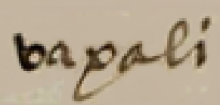huapalli (CST19)
This painting of the simplex glyph for the term huapalli (planks, boards, small beams) shows a horizontal pile of rectangular pieces of wood. The color is red. The companion text explains that these beams were used for roofing the chapel/baptistry. For the transcription and translation of the text, see Kevin Terraciano’s study of the Codex Sierra (2021).
Stephanie Wood
See the glyph below that shows how upright beams were used in building construction and how they were dragged into place with a rope (involving the verb, huilana).
Stephanie Wood
1550–1564
Jeff Haskett-Wood
vigas, tablas, tablones, construcción, arquitectura

huapal(li), plank, board, small beam, https://nahuatl.wired-humanities.org/content/huapalli
vigas pequeñas
Stephanie Wood
Códice Sierra-Texupan, plate 19, page dated 1558. Origin: Santa Catalina Texupan, Mixteca Alta, State of Oaxaca. Kevin Terraciano has published an outstanding study of this manuscript (Codex Sierra, 2021), and in his book he refers to alphabetic and “pictorial” writing, not hieroglyphic writing. We are still counting some of the imagery from this source as hieroglyphic writing, but we are also including examples of “iconography” where the images verge on European style illustrations or scenes showing activities. We have this iconography category so that such images can be fruitfully compared with hieroglyphs. Hieroglyphic writing was evolving as a result of the influence of European illustrations, and even alphabetic writing impacted it.
https://bidilaf.buap.mx/objeto.xql?id=48281&busqueda=Texupan&action=search
The Biblioteca Digital Lafragua of the Biblioteca Histórica José María Lafragua in Puebla, Mexico, publishes this Códice Sierra-Texupan, 1550–1564 (62pp., 30.7 x 21.8 cm.), referring to it as being in the “Public Domain.” This image is published here under a Creative Commons license, asking that you cite the Biblioteca Digital Lafragua and this Visual Lexicon of Aztec Hieroglyphs.






